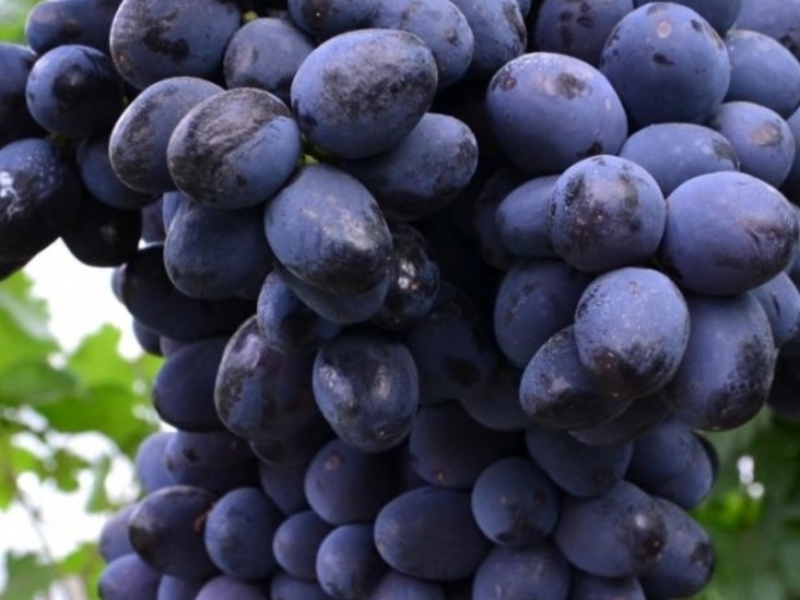 Grapes "Fun" has become a real property of Ukrainian selection. The variety was bred by Zagorulko V.V., crossing grapes “Kodryanka” and “Laura”. Some gardeners used to call him "Laura black."
Grapes "Fun" has become a real property of Ukrainian selection. The variety was bred by Zagorulko V.V., crossing grapes “Kodryanka” and “Laura”. Some gardeners used to call him "Laura black."
Berry culture gained its popularity not only in Ukraine, but also in Belarus and Russia.
Content
Grape characteristics
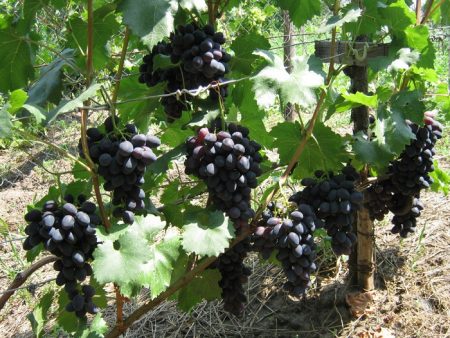 Grapes ripening early, 100-120 days. Resistance to frost is average. In winter, it can withstand a decrease in temperature to -18-21 ° C. Therefore, shelters are required in very cold regions. The variety is resistant to gray rot and oidium, but is often attacked by mildew. The main pest that spoils the crop are wasps. To protect the fruits, they are covered with nets, set traps with sweet syrup. The berry culture belongs to hybrid varieties, but it can be tapped, thus multiplying the plant.
Grapes ripening early, 100-120 days. Resistance to frost is average. In winter, it can withstand a decrease in temperature to -18-21 ° C. Therefore, shelters are required in very cold regions. The variety is resistant to gray rot and oidium, but is often attacked by mildew. The main pest that spoils the crop are wasps. To protect the fruits, they are covered with nets, set traps with sweet syrup. The berry culture belongs to hybrid varieties, but it can be tapped, thus multiplying the plant.
Plant description
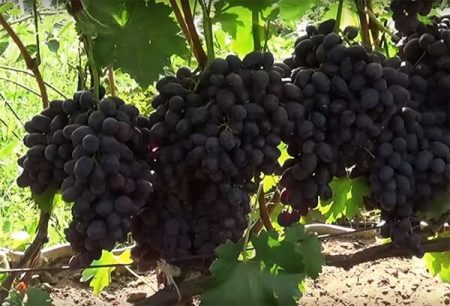 Bushes "Fun" powerful, sprawling. In the first year of growth, the vine reaches 1-2 meters, by the second, it grows to 4 meters. Ripens well. Begins to bear fruit in the second year after planting. On the bush, in the first year of fruiting, up to 10-12 clusters are formed. During this period, it is worth half the bunches to break off to give strength to the full ripening of the vines and the formation of large berries on the bunches.
Bushes "Fun" powerful, sprawling. In the first year of growth, the vine reaches 1-2 meters, by the second, it grows to 4 meters. Ripens well. Begins to bear fruit in the second year after planting. On the bush, in the first year of fruiting, up to 10-12 clusters are formed. During this period, it is worth half the bunches to break off to give strength to the full ripening of the vines and the formation of large berries on the bunches.
In the second and subsequent years, up to 30 clusters are formed on grapes. With such a load, they manage to mature by mid-August. After ripening, the fruits on the grapes can hang for another month, without losing their appearance and taste. Berries are not prone to cracking and decay, even if there is a period of prolonged rains.
Five-bladed leaf plates, a dissected border is traced along the edges. They are painted in dark green color. The flowers are small, light green in color, self-pollinated. The clusters are not dense, on average, the weight of one reaches 700-800 grams. Subject to proper agricultural technology, clusters can grow up to 1.5 kilograms.
The berries are formed oval-oblong. The weight of one reaches 10 grams. The skin is thin, painted in dark blue with a purple tint. The surface of the grapes is covered with a wax coating, which allows them to be well stored for a long time. The pulp is dense, almost non-mucous, cracking when cracked, the dessert taste. Productivity from one bush reaches 20-25 kilograms.
Advantages and disadvantages of grapes
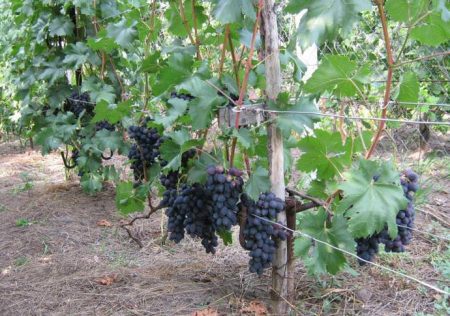 The table variety "Fun" has many advantages that make it popular. Among the main distinguish:
The table variety "Fun" has many advantages that make it popular. Among the main distinguish:
- excellent taste;
- annual abundant fruiting;
- excellent presentation;
- high transportability over long distances;
- good immunity to certain diseases.
The disadvantages of berry culture include:
- average frost resistance;
- high mildew lesion.
Grape growing and care
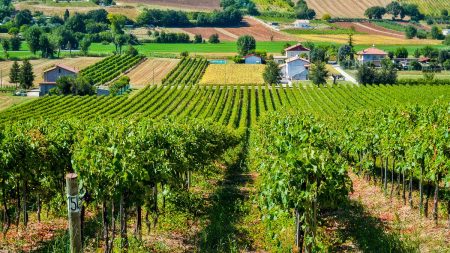 Propagated berry culture by cuttings. They can be rooted or grafted to other grape varieties. Cuttings are cut in late autumn, when they are lignified. Powerful branches are chosen, 15 centimeters are cut from them. The resulting parts of the vine are called chubuk. They are put in a plastic bag, stored in the winter in the cellar or in the refrigerator. Beginning in late February and early March, gardeners have been engaged in the rooting process. At one end of the chubuk, a small cut is made, not more than 5 millimeters, then, where the cut end is, the chubuk is placed in water for 2 days. Water changes during this period 2-3 times.
Propagated berry culture by cuttings. They can be rooted or grafted to other grape varieties. Cuttings are cut in late autumn, when they are lignified. Powerful branches are chosen, 15 centimeters are cut from them. The resulting parts of the vine are called chubuk. They are put in a plastic bag, stored in the winter in the cellar or in the refrigerator. Beginning in late February and early March, gardeners have been engaged in the rooting process. At one end of the chubuk, a small cut is made, not more than 5 millimeters, then, where the cut end is, the chubuk is placed in water for 2 days. Water changes during this period 2-3 times.
While the Chubuki are saturated with water, they prepare containers in which the root system of future grape seedlings will develop. As a container, you can take eggplant from under the water. Cutting off the neck they can be filled with a substrate. A filler is being prepared from 10 kilograms of sod land, 10 kilograms of humus, 5 kilograms of sawdust and 5 kilograms of sand. All elements are thoroughly mixed. In order for the substrate to become nutritious, top dressing is added to it. Liquid fertilizer is prepared on the basis of 5 liters of water, 5 grams of saltpeter and 10 grams of superphosphate. The resulting solution spills the filler.
Tanks are filled with a substrate. Chubuki are placed in them so that only two eyes remain on the surface. They put cuttings to develop in warm rooms (it is desirable that this be a greenhouse). A glass jar or a cut bottle is put on top of the cuttings. Water them as the soil dries. When shoots begin to appear on the forelocks, they can be transplanted into the soil.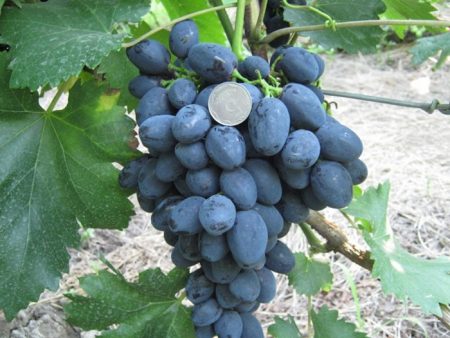
Before planting in open ground, for two weeks, the seedlings are tempered. Every day for 14 days they are taken out to fresh air. On the first day they leave it on the street for half an hour, and then every day they gradually add the time spent in the open area.
Blooming cuttings are planted when the air warms up by at least + 15-18 ° С., And the soil temperature at a depth of 20-25 centimeters reaches + 10-12 ° С. The height and width of the landing pit should be 80 centimeters. At the bottom there is a “nutrient pillow” made of humus and earth (3 kg of humus and 3 kg of earth). It should be 30 centimeters. Then,
the seedling is placed in a pit and sprinkled with earth, not filling the soil 10 centimeters. After which, 3 buckets of water are poured into the basal space. The next day, the soil is loosened so that oxygen is better supplied to the root system.
Grape care involves:
- Watering. For the normal development of berry culture, a large amount of moisture is needed. Over the entire growing season, from awakening to the start of ripening, the bushes are watered at least 5 times, with a frequency of 14 days. Under one plant, 30-40 liters of water are poured. The last watering is carried out in late autumn, 50-60 liters of water are poured under the bush.
- Mulching the soil. So that moisture evaporates less from the soil, the soil under the plant is mulched with straw, sawdust, and hay. The layer of the selected material should be 5-10 centimeters.
- Shelter for the winter. In the southern regions of the country, grapes are not needed. But in the middle lane and in the North, it is worth taking care of sheltering the vines for the winter. Bushes must be removed from the arch, carefully tied and bent to the surface of the earth.
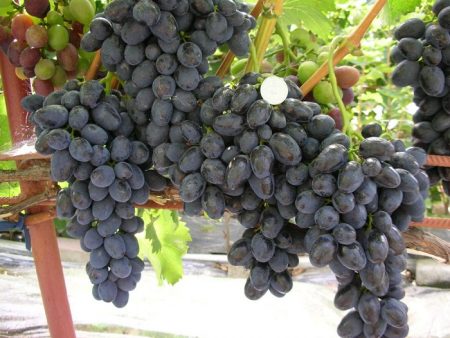
It is impossible to bend the vine strongly, it can begin to rot. Slate or plywood is placed under the bottom so that the grapes do not come into contact with the soil.
Then, the grapes are covered with straw or hay. And so that the wind does not pull away the light material, it is covered with a plastic film on top.
- Pruning vines. To normalize the load on the bushes, they are cut every year. Weak shoots are subject to complete removal. Strong lignified branches are pruned at the level of 6-8 ocelli. In this case, 30-45 eyes will remain on the shrub. It is recommended to prune in early spring, when sap flow has not yet begun.
- Feeding. In spring, liquid top dressing of superphosphate (20 g), carbamide (10 g), potassium sulfate (10 g) and 10 liters of water is added under the grapes. The second time they feed before flowering, use the same fertilizer as in spring. Humus is introduced in the fall. Consumption per bush is 2 buckets. Fertilize not under the root throughout the basal area.
- Protection against diseases. Grapes "Fun" is struck by mildew.To prevent the disease, in the spring the plants are sprayed with Bordeaux liquid (10 l of water, 100 g of copper sulfate and 120 g of hydrated lime).
Gardeners reviews
Gardeners from central Russia and the South speak of grapes positively. A big disadvantage for middle-aged growers is the low frost tolerance threshold, but other positive qualities completely block this negative side. To prevent grapes from getting sick, gardeners recommend spraying the plants twice in the spring. Most use copper-based products. The first time spraying is carried out when the buds have not yet blossomed, and the second time when the leaves have already blossomed.




 Non-covering winter-hardy grape varieties for Moscow region
Non-covering winter-hardy grape varieties for Moscow region How to keep the vine in winter
How to keep the vine in winter When can I transfer grapes to another place in the fall
When can I transfer grapes to another place in the fall How to cover and prepare grapes for the winter in the suburbs
How to cover and prepare grapes for the winter in the suburbs